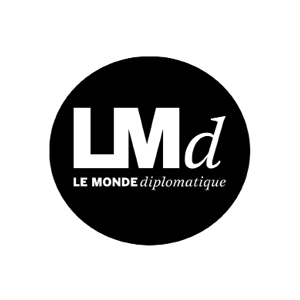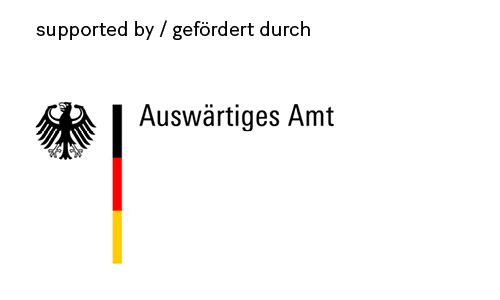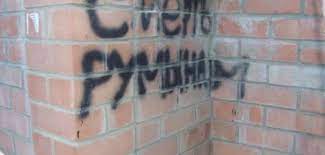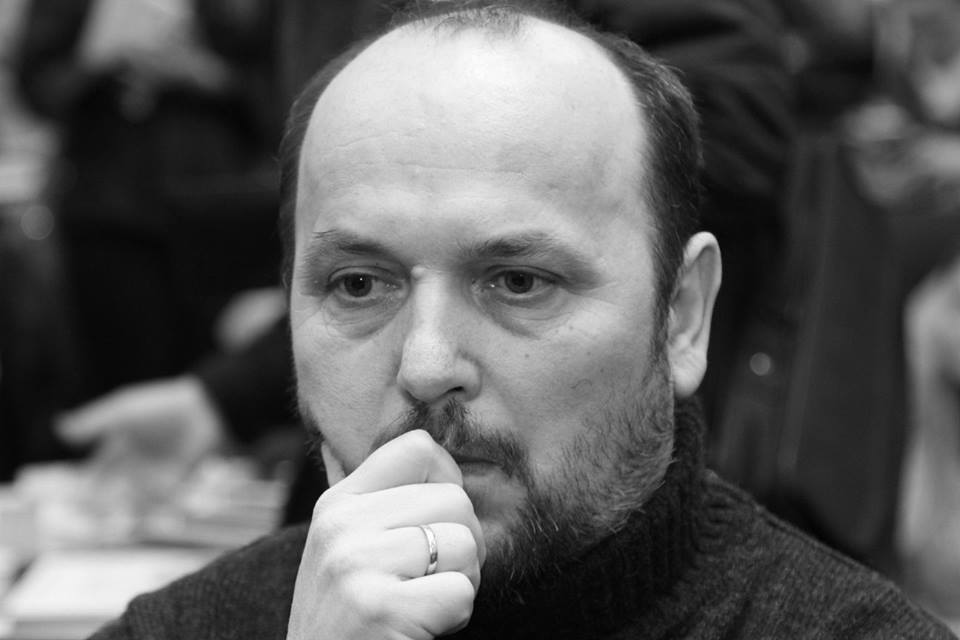Smerti Rumânam/ Moarte Românilor
Acest îndemn în limba rusă de-a fi omorâți românii a apărut pentru prima data la Chișinău în primăvara lui 2014, după ce Rusia a ivadat Ucraina, ocupând Crimeea și o mare parte din Donbass. Apoi a fost șters, după care iar a apărut. A doua oară a apărut după 24 februarie 2022, când Rusia a pornit un nou război contra Ucrainei. Ceea ce m-a izbit din capul locului e că e scris în rusă și că a fost inscripționat în același loc: pe un zid de cărămidă roșie de pe strada Neaga, care separă clădirea cu nouă etaje de la intersecție de trotuarul pe care circulă pietonii, unii dintre ei către secția de pașapoarte de peste drum. De fiecare data când am dat de acest îndemn, m-am gândit de ce l-au inscipționat pe un zid – tot timpul pe același zid- de pe strada Neaga, o stradă din cartierul Buiucani și nu în centrul orașului, să zicem, pe bulevardul Ștefan cel Mare? Au vrut să-I sperie pe cei care locuiesc în blocul cu nouă etaje sau pe cei care trec pe acolo în drumul lor spre secția de pașapoarte? Să locuiască oare în clădirea din spatele zidului, pe care apare inscripția, niște oameni incomozi? Dar incomozi cui? Pe cine să fi deranjat? Pe cei care nu sunt români? Dar cei care nu sunt români sunt doar vreo zece procente, majoritatea populaţiei din Republica Moldova fiind compusă din români ( care își mai spun și moldoveni, dar, de fapt, tot români sunt, și vorbesc limba română, care e limba de stat a republicii Moldova).
Într-o zi am vorbit cu cineva din acest bloc de pe strada Neaga și am aflat că în el locuiesc oameni obișnuiți, printre ei nu e nici măcar un singur om politic sau vreun activist civic. Oameni ca toţi oameni. Români ca toţi românii, așa cum sunt majoritatea celor care locuiesc în Republica Moldova. Deci problema nu e că printre cei care locuiesc în acel bloc ar fi vreun om cu vederi politice radicale, pentru că nu este, ci e în altă parte. Cei care au scris inscripția pe zid au îndreptat-o contra tuturor românilor ( sau moldovenilor) din Republica Moldova, vrând să-I sperie, să-I intimideze, să-I demoralizeze, nu doar contra celor care locuiesc în blocul de pe strada Neaga. Ca, în primul rând, să-I înfricoșeze. Cei care l-au scris, au transmis un avertisment. Vom ajunge și la voi și ne vom răfui și cu voi, nu doar cu ucrainenii.
De ce n-a fost scris în română și de ce a fost scris în rusă? Pentru a ne spune că războiul se apropie, pentru a ne spune, că, în curând, așa speră ei, îl vor purta și pe teritoriul țării noastre, când vor transforma în Realitate această amenințare sinistră, care îi îndeamnă pe ruși să-i omoare pe români.
M-am mai gândit la un lucru, că inscripția a apărut de fiecare data când rușii au invadat Ucraina. Scrisă cu litere negre, morbide, îndoliate, pe acel zid de cărămidă roșie, îm amintește de felul cum Stalin a exterminat populația românească din Republica Moldova, după ce ne-au ocupat. Au vrut să șteargă orice urmă românească din zona noastră, pentru a-și justifica ocupația. Moartea românilor nu mai era doar un slogan, era o practică uzuală.
Spuneam că acest îndemn xenofob și putinist a fost șters de pe zid. Trebuie să vă spun deschis că nu a fost șters de reprezentanții primăriei, poliției, procuraturii, ci de mine însumi. Eu însumi am luat un șprei, de la un prieten pictor, și am acoperit inscripția cu un strat de vopsea. Dar a apărut din nou, după ce Rusia a invadat Ucraina.
Smerti rumânam/ moarte românilor. Mie mi se pare ceva foarte nasol, dar nu și poliției sau procuraturii, care nu au declanșat nicio cauză de urmărire penală, pentru a da de urmele autorului acestei inscripţii funebre și războinice.
Același prieten pictor mi-a dat un tub de vopsea neagră și am șters iar inscripția de pe zidul de pe strada Neaga. Am fost azi și am acoperit-o cu un strat gros de vopsea neagră. Negru doar cu negru poate fi scos.
Smerti rumânam/ moarte românilor. Acest îndemn seamănă cu o declarație de război. Oare, peste un timp, o să reapară iar pe acest zid?
Smert Rumynam/ Tod den Rumänen
Dieser Aufruf in russischer Sprache, Rumänen zu töten, tauchte in Chișinău zum ersten Mal im Frühjahr 2014 auf, nachdem Russland in die Ukraine eingedrungen war und die Krim sowie einen Großteil des Donbass besetzt hatte. Dann wurde der Aufruf entfernt, woraufhin er erneut auftauchte. Zum zweiten Mal tauchte er nach dem 24. Februar 2022 auf, als Russland einen neuen Krieg gegen die Ukraine begann. Mir stach sofort ins Auge, dass er auf Russisch geschrieben und an derselben Stelle angebracht worden war: an einer roten Ziegelmauer in der Neaga-Straße, die das neunstöckige Gebäude an der Kreuzung vom Bürgersteig trennt, auf dem Fußgänger unterwegs sind, darunter so manch einer zum Passamt gegenüber. Jedes Mal, wenn ich auf diesen Aufruf stieß, überlegte ich, warum sie ihn an eine Mauer geschrieben haben – immer an dieselbe Mauer – in der Neaga-Straße, eine Straße im Stadtviertel Buiucani, und nicht im Stadtzentrum, sagen wir auf dem Boulevard Ştefan der Große? Wollten sie die Bewohner des neunstöckigen Wohnblocks erschrecken oder die Passanten dort auf ihrem Weg zum Passamt? Wohnen etwa in dem Gebäude hinter der Mauer, an der die Aufschrift steht, irgendwelche unbequemen Leute? Aber für wen unbequem? Wen sollten sie gestört haben? Diejenigen, die keine Rumänen sind? Aber die machen nur etwa zehn Prozent aus, die Mehrheit der Bevölkerung der Republik Moldau besteht aus Rumänen (die sich auch Moldauer nennen, aber eigentlich ebenfalls Rumänen sind und Rumänisch sprechen, die Staatssprache der Republik Moldau).
Eines Tages unterhielt ich mich mit einem Bewohner dieses Hauses in der Neaga-Straße und erfuhr, dass darin ganz gewöhnliche Leute wohnen, darunter kein einziger Politiker oder irgendein Bürgeraktivist. Menschen wie du und ich. Alles normale Rumänen, so wie die meisten Bewohner der Republik Moldau. Also besteht das Problem nicht darin, dass unter den Bewohnern dieses Hauses irgendein Mensch mit radikalen politischen Ansichten ist, weil es den nicht gibt, sondern das Problem liegt woanders. Diejenigen, die an die Mauer schrieben, wenden sich an alle Rumänen (oder Moldauer) der Republik Moldau und nicht nur an die Bewohner des Hauses in der Neaga-Straße, sie wollen sie erschrecken, einschüchtern und demoralisieren. Vor allem sollen sie Angst bekommen. Die Verfasser übermitteln eine Warnung. Zu euch werden wir auch noch kommen und mit euch ebenso abrechnen, nicht nur mit den Ukrainern.
Warum wurde das nicht auf Rumänisch geschrieben und warum wurde es auf Russisch geschrieben? Um uns zu sagen, dass der Krieg näher kommt, um uns zu sagen, dass sie ihn hoffentlich bald auch auf das Territorium unseres Landes tragen und dann diese finstere Drohung, mit der Russen aufgerufen sind, Rumänen zu töten, wahr machen werden.
Ich habe auch darüber nachgedacht, dass die Aufschrift jedes Mal auftauchte, wenn die Russen in die Ukraine einfielen. Geschrieben mit schwarzen, morbiden, Trauer verkündenden Buchstaben an diese rote Ziegelmauer, erinnert sie mich daran, wie Stalin die rumänische Bevölkerung der Republik Moldau vernichtete, nachdem er uns besetzt hatte. Sie wollten jedwede rumänische Spur auf unserem Gebiet auslöschen, um ihre Besetzung zu rechtfertigen. Der Tod der Rumänen war nicht nur ein Slogan, er war eine übliche Praxis.
Ich schrieb, dass diese xenophobe und putinsche Aufschrift von der Mauer entfernt wurde. Ich muss Ihnen ganz ehrlich sagen, dass sie nicht von den Mitarbeitern der Stadtverwaltung, der Polizei oder der Staatsanwaltschaft entfernt wurde, sondern von mir. Ich hatte mir von einem befreundeten Maler ein Spray geholt und die Aufschrift mit einer Schicht Farbe übersprüht. Aber nach dem Überfall Russlands auf die Ukraine stand sie wieder da.
Smert rumynam/ Tod den Rumänen. Für mich hört sich das ziemlich abscheulich an, aber nicht so für die Polizei oder die Staatsanwaltschaft, die keinerlei Strafverfolgung eingeleitet haben, um den Verfasser dieser düsteren und kriegerischen Aufschrift ausfindig zu machen.
Derselbe Malerfreund gab mir eine Tube mit schwarzer Farbe und erneut überstrich ich die Aufschrift an der Mauer in der Neaga-Straße. Heute war ich dort und habe sie mit einer dicken, schwarzen Farbschicht bedeckt. Schwarz kann nur mit Schwarz getilgt werden.
Smert rumynam/ Tod den Rumänen. Dieser Aufruf kommt einer Kriegserklärung gleich. Ob er wohl bald wieder an dieser Mauer stehen wird?
Übersetzung: Anke Pfeifer
Smert' Rumynam/ Death to Romanians
This call in the Russian language to kill Romanians first appeared in Chișinău in the spring of 2014, after Russia invaded Ukraine, occupying Crimea and a large part of Donbass. Then it was erased, but it later reappeared. The second time it appeared was after 24 February 2022, when Russia began a new war against Ukraine. What struck me right away was that it was written in Russian and inscribed on the same place: on a red brick wall on Neaga street, which separates the nine-storey building at the intersection from the sidewalk used by pedestrians, some of whom are headed to the passport office across the road. Each time I came across this call, I wondered why they inscribed it on a wall—always the same wall—on Neaga street, a street in the Buiucani neighborhood, and not in the city center, for example on Ștefan the Great boulevard? Did they want to scare the people who lived in the nine-storey apartment building or those who cross there on their way to the passport office? Was it possible that in the building behind the wall with the writing on it, lived people whose presence was inconvenient? But inconvenient for whom? Who would they be bothering? People who aren’t Romanian? But non-Romanians make up only about 10% of the population of the Republic of Moldova, the majority being Romanians (who also call themselves Moldovans, but they’re still Romanians, and they speak Romanian, which is the official language of the Republic of Moldova).
One day I spoke with someone from the building on Neaga street and found out that ordinary people lived there, not a single political or social activist among them. Regular people. Regular Romanians, same as the majority who live in the Republic of Moldova. So the problem wasn’t that there is someone with radical political views who lives in that building, because there isn’t, but it’s something else. Those who wrote on the wall were addressing all Romanians (or Moldovans) in the Republic of Moldova, wanting to scare them, intimidate them, demoralize them, not just those who lived in the building on Neaga street. To, first and foremost, terrorize them. The people who wrote it sent a warning. We’ll get to you too and deal with you, not just the Ukrainians.
Why wasn’t it written in Romanian but in Russian? To communicate to us that war is coming, to tell us that, soon, that’s what they hope, they’ll wage it on our territory as well, when they’ll transform this sinister threat, which calls for Russians to kill Romanians, into Reality.
I thought about something else related to the fact that the writing appeared each time Russians invaded Ukraine. Written in black letters, morbid and mournful, on that red brick wall, it reminded me of how Stalin exterminated the Romanian population in the Republic of Moldova after they occupied us. They wanted to wipe out any trace of Romanians from our region, in order to justify their occupation. Death to Romanians wasn’t just a slogan then, it was a regular practice.
I had said that this bigoted, pro-Putin message had been erased from the wall. I have to tell you openly that it wasn’t erased by representatives of city hall, the police, or the district attorney’s office, but by me. I, myself, took a can of spray paint, borrowed from an artist friend, and covered over the message with a layer of paint. But it reappeared after Russia invaded Ukraine.
Smert‘ rumynam / death to Romanians. I find it really disgusting, but the police and the district attorney’s office don’t seem to feel the same, given that they didn’t launch a criminal investigation in order to find the author of this lurid and war-mongering message.
The same artist friend gave me a tube of black paint and I again erased the writing on the wall on Neaga street. I went by today and covered over it with a thick coat of the black paint. Only black can get out black.
Smert‘ rumynam / death to Romanians. This call is like a declaration of war. Will it, after a while, reappear again on this wall?
Translation: Monica Cure
Teilen












